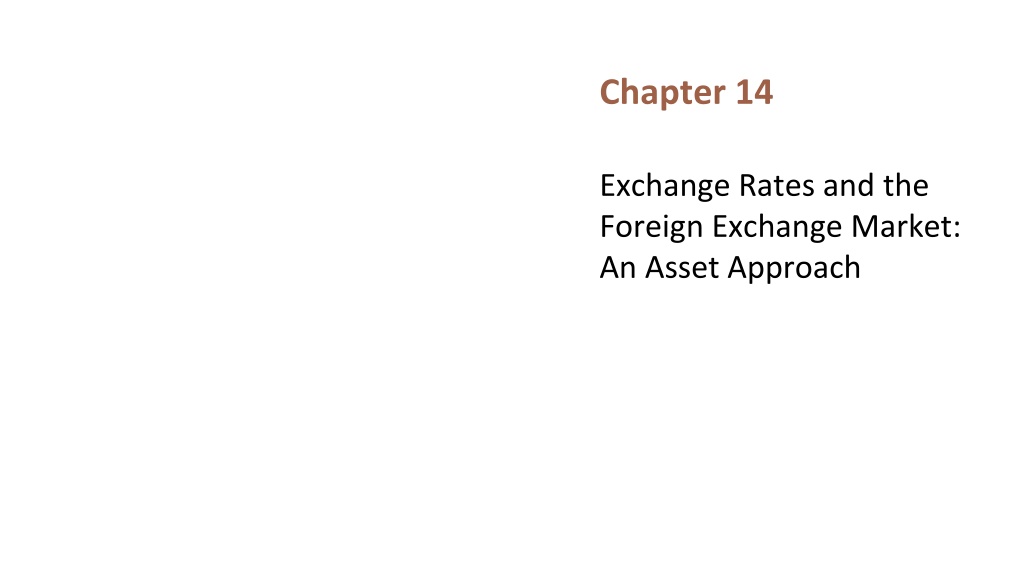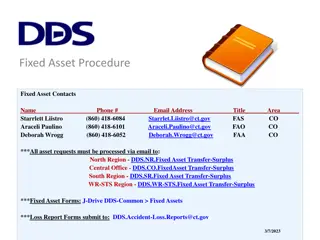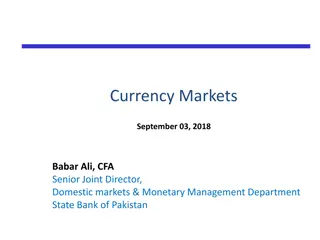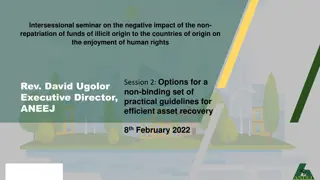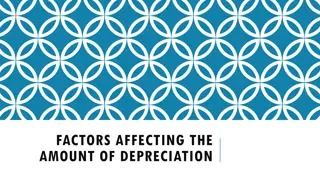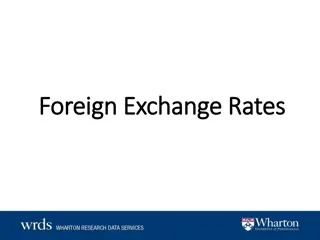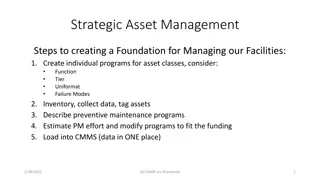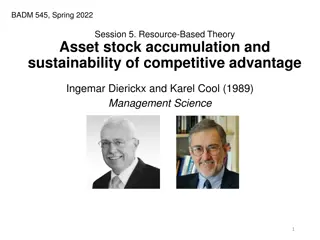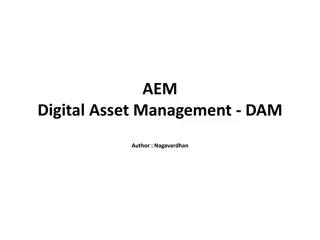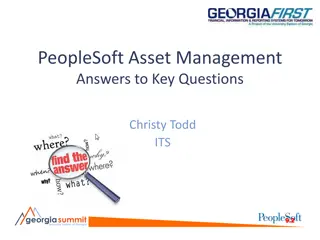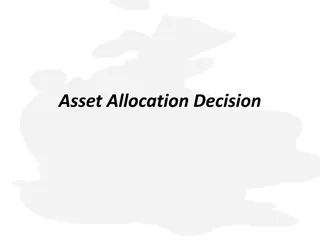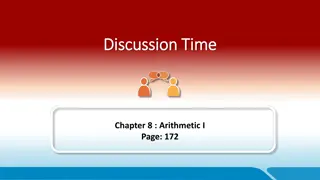Understanding Exchange Rates: An Asset Approach
This chapter delves into the concept of exchange rates and the foreign exchange market from an asset approach perspective. It covers topics such as exchange rate quotations, domestic and foreign currencies, definitions of exchange rates, depreciation, appreciation, and examples illustrating these concepts. Through this comprehensive guide, readers can gain a deeper understanding of how exchange rates impact international trade and the relative values of currencies.
Download Presentation

Please find below an Image/Link to download the presentation.
The content on the website is provided AS IS for your information and personal use only. It may not be sold, licensed, or shared on other websites without obtaining consent from the author. Download presentation by click this link. If you encounter any issues during the download, it is possible that the publisher has removed the file from their server.
E N D
Presentation Transcript
Chapter 14 Exchange Rates and the Foreign Exchange Market: An Asset Approach
Table 14-1: Exchange Rate Quotations Value of $1.00
Domestic and Foreign Currencies In these lectures, domestic currency refers to the US dollar Foreign currency refers to the Euro, or at times to the Yen or the Yuan The exchange rate is defined here as the price of the foreign currency So, the exchange rate is the amount of the domestic currency that one unit of the foreign currency is worth Its symbol is E Example: if 1 is worth $1.54, then E = 1.54
Definitions of Exchange Rates Exchange rates allow us to show the price of a good or service in any currency. Example: What is the price of a Honda Accord? 3,000,000 Q: In dollars? Suppose 1 is worth $0.0098: E = 0.0098 A: 3,000,000 x $0.0098 = $29,400
Depreciation and Appreciation Depreciation is a decrease in the price of a currency (relative to another currency). Appreciation is an increase in the price of a currency (relative to another currency).
Depreciation and Appreciation Example: 1 used to be worth $1. Now 1 is worth $1.46. E has increased from 1.00 to 1.46 The price of a euro has increased. It has appreciated. So, the price of a dollar has decreased. It has depreciated. As E is the price of the foreign currency, an increase in E means the foreign currency has appreciated and the domestic currency has depreciated
Depreciation and Appreciation As E is the value of the euro in dollars, E means appreciation of the euro (and depreciation of the dollar) E means depreciation of the euro (and appreciation of the dollar)
Depreciation and Appreciation: Example Suppose the foreign currency is the Japanese yen Then E is the dollar value of the yen Suppose E increases from $0.0098 to $ 0.0100. A Honda Accord costs 3,000,000. What is it in dollars? Suppose E = 0.0098 3,000,000 0.0098 = $29,400 Suppose E = 0.0100 3,000,000 0.0100 = $30,000 E means the foreign currency is more expensive which means foreign goods are more expensive
Depreciation and Appreciation Foreign Currency Domestic Currency Foreign country s exports Domestic country s exports E Appreciation Depreciation More expensive Less expensive E Depreciation Appreciation Less expensive More expensive
Rate of Depreciation and Appreciation Suppose E increases from $0.0098 to $ 0.0100. Q: What is the rate of the appreciation? A: rate of appreciation =appreciation original value So, rate of appreciation = ?????? ???????? ???????? So, rate of appreciation =0.0100 0.0098 = 0.02 or 2 percent 0.0098
How are exchange rates determined? The exchange rate (E) is a price It may be the price of one currency in units of another, but it is a price nevertheless And people buy and sell currencies just like they trade goods and services So, the familiar theory of supply and demand can be used to explain what determines the exchange rate and what makes the exchange rate fluctuate
The Foreign Exchange Market The main participants: 1. Commercial banks and other depository institutions: their transactions involve buying/selling of bank deposits in different currencies for their clients. 2. Non bank financial institutions (pension funds, insurance funds) may buy/sell foreign assets. 3. Private firms: they conduct foreign currency transactions to buy/sell goods, assets or services. 4. Central banks: conduct official international reserves transactions. 5. Private individuals, such as tourists
In which country should you keep your savings? This chapter focuses on currency trades that are motivated by our constant search for a good return on our savings If you think that your savings would grow fastest in a European bank, you will need to Turn your US dollars into euros, and then Deposit your euros in a European bank Such trades represent supply and demand in currency markets
Where would you keep a dollar? In an American bank Deposit dollar in bank A year later, the bank gives you your dollars back with interest In a European bank Buy euros with dollar Deposit euros in bank A year later, the bank gives you your euros back with interest Sell the euros and get dollars
Where would you keep a dollar? In an American bank Deposit dollar in bank A year later, the bank gives you your dollars back with interest In a European bank Buy euros with dollar You want E to be low Deposit euros in bank A year later, the bank gives you your euros back with interest You want R, the domestic interest rate to be high You want R*, the foreign interest rate to be high Sell the euros and get dollars Now, you want E to be high
Where would you keep a dollar? In an American bank Deposit dollar in bank A year later, the bank gives you your dollars back with interest In a European bank Buy euros with dollar You want today s E to be low Deposit euros in bank A year later, the bank gives you your euros back with interest You want R, the domestic interest rate today, to be high You want R*, the foreign interest rate today, to be high Sell the euros and get dollars You want future E to be high
Where would you keep a dollar? In an American bank Deposit dollar in bank A year later, the bank gives you your dollars back with interest In a European bank Buy euros with dollar You want today s E to be low Deposit euros in bank A year later, the bank gives you your euros back with interest You want R, the domestic interest rate today, to be high You want R*, the foreign interest rate today, to be high Sell the euros and get dollars Even if R > R*, keeping your wealth in euros may be a good idea if the euro is expected to appreciate You want future E to be high Even if R < R*, keeping your wealth in dollars may be a good idea if the euro is expected to depreciate
Where would you keep a dollar? In an American bank Deposit dollar in bank A year later, the bank gives you your dollars back with interest In a European bank Buy euros with dollar You want today s E to be low Deposit euros in bank A year later, the bank gives you your euros back with interest You want R, the domestic interest rate today, to be high You want R*, the foreign interest rate today, to be high Sell the euros and get dollars When you deposit your money in a US bank, the only thing that matters to you is R You want future E to be high When you deposit your money in a European bank, three things matter to you: R*, today s E, and future E.
The Demand for Foreign Currency Assets Suppose today $1 = 1: that is, E = 1. Suppose the exchange rate expected to be $0.97 = 1 one year in the future: that is, Ee = 0.97. Therefore, the euro is expected to increase at the rate (0.97 1.00)/1.00 = 0.03. This is a 3 percent depreciation E e e E E E = In general, the expected rate of appreciation in E is: 1 E
The Demand for Foreign Currency Assets Therefore, the dollar rate of return on Euro denominated deposits approximately equals the interest rate on euro deposits, R* plus the expected rate of appreciation on euro deposits (Ee E)/E. This is: e E E + * R E
The Market for Foreign Exchange The foreign exchange market is in equilibrium when deposits in all currencies offer the same expected rate of return. This condition is called interest parity e E E = + * R R E
The Interest Parity Condition e E E = + * R R E e E = + * 1 R R E
The Interest Parity Condition The interest parity condition for equilibrium in the market for foreign exchange provides a link between four variables: R, R*, E, and Ee. Therefore, if the values of any three variables are known, the value of the fourth can be calculated e E = + * 1 R R E
The Interest Parity Condition Moreover, if the changes over time in any three variables are known, the change in the fourth can be calculated The resulting predictions may be testable e E = + * 1 R R E
The Market for Foreign Exchange (cont.) e How do changes in the current exchange rate affect expected returns in foreign currency deposits? If E , or Ee , or R* , then the rate of return on euro bank deposits . Therefore, for equilibrium to be maintained, R . E E = + * R R E e E = + * 1 R R E
The Market for Foreign Exchange (cont.) e E What can the market for foreign exchange tell us about exchange rates? If R , or Ee , or R* , then E . = + * 1 R R E e E + = * 1 R R E e E = E *+ 1 R R
The Risk Premium So far, we have assumed that domestic and foreign financial assets are equally risky This assumption may not always be correct Q: What if foreign assets are riskier (than domestic assets)? A: People will not buy foreign assets unless they are compensated for the added risk. This additional payment is the risk premium ( )
The Risk Premium When people refuse to buy foreign assets without being paid the additional risk premium, , the interest parity equation becomes e E = + + * 1 R R E See equation (18-2) of the textbook
